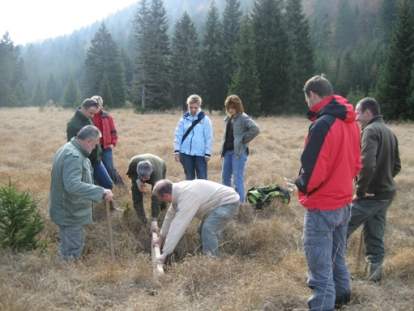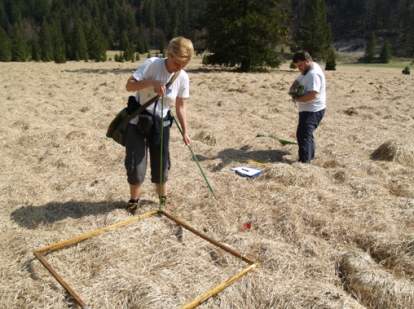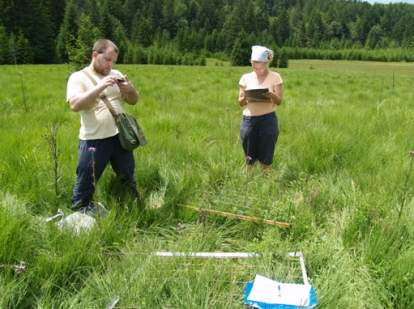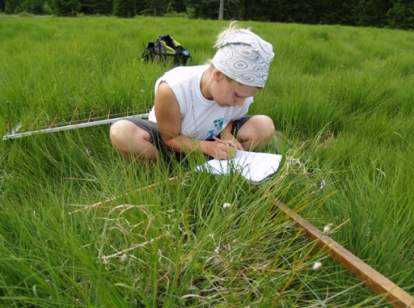
Photo 1. Employees of the Klana Forest Area Office, the Natural History
Museum Rijeka, the State Institute for Nature Protection, and the PI “Priroda”
placing wooden barriers in drainage canals on Trstenik Mire (Photo by
M. Cindrić)MULTI-ANNUAL PROJECT TO MONITOR AND REVITALISE THE REMAINS OF AN OMBROTROPHIC BOG INITIATED AT TRSTENIK MIRE NEAR KLANA
For a number of years, the professionals of the Natural
History Museum Rijeka have been carrying out botanical and ecological
research of Trstenik Mire near Klana. Pipes were placed to measure freatic
water levels on sample plots, and during 2009, a control measuring of
water levels was conducted for a one-year period. A highly attractive
part of the landscape, Trstenik Mire is an Ice Age relict and the only
remnant of a raised (ombrotrophic) mire habitat in Croatia, also the only
known locality for several threatened plant species in Croatia. In the
spring of 2010, 180 permanent sample plots along four radial transects
(A, B, C and D) were laid out in this area, which will be used to monitor
underground water levels and the condition of plant life.
This was the beginning of a complex project to monitor
a natural asset in the National Ecological Network over a period of several
years. Trstenik Mire is an instructive example of the harmful effect of
people on a natural asset (now a part of the National Ecological Network
with prescribed protection measures). Namely, several decades ago, drainage
canals were dug to dry out the bog, and attempts were made at afforestation.
These actions continue to have a negative impact on the condition of the
bog, leading to its degradation. The outer margin of the bog that have
been successfully afforested with spruce have completely lost their bog
features. With the cooperation of the Klana Forest Area Office, dozens
of wooden barriers (made of oak, which has a low pH compatible with the
low pH values of bog habitats) have been placed in the drainage canals.
The aim is to reduce the drainage of the ombrotrophic bog, that is, to
reduce the loss of water the ombrotrophic part of the mire receives through
precipitation, while abating the harmful effects of attempts to drain
and dry out the bog. Also, in the fall of 2009, it was agreed with the
Klana Forest Area Office to eliminate some of the spruce trees that present
a threat to the bog by accelerating vegetation succession, shading and
increasing evapotranspiration. A part of the spruce trees were cut down
in the early spring of 2010, while the rest will be felled at the end
of the year. To determine the effectiveness of measures taken, the total
ground water level is continuously measured, twice a month, on the four
transects on the bog.
On 14 July 2010, purple moor grass (Molinia caerulea),
which is overgrowing the bog and has a negative effect on rare and threatened
bog species, was mowed in half of the pemanent sample plots. The aim was
to determine whether mowing could help in the conservation of rare and
threatened bog species, as well as in the revitalisation of the bog habitat,
and if so, to establish other appropriate activities to be undertaken
on the bog. Also, in the fall of 2010, attempts will be made to transplant
peat mosses (Sphagnum spp.) from the bog’s better-preserved areas to several
sample plots along its margin.
All activities in monitoring and revitalising the bog habitat are carried
out by the Public Institution “Priroda”, together with the professionals
of the Natural History Museum Rijeka and in cooperation with the Klana
Forest Area Office, as part of a multi-annual project. The permanent monitoring
of Trstenik Mire is the first project of its kind in Croatia. It is expected
to provide important information and experience that will facilitate the
implementation of similar projects in protecting and revitalising other
threatened bog habitats and species in Croatia.
M. Randić and Ž. Modrić Surina

Photo 2. Laying out permanent sample plots in spring 2010 (Photo by M.
Randić)

Photo 3. Professionals of the Natural History Museum Rijeka and the PI
“Priroda” conducting monitoring activities on the bog (Photo
by M. Randić)

Photo 4. Documenting plant species in permanent sample plots (Photo by
M. Randić)



